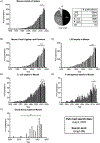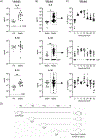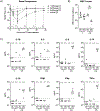Mouse Models of Sepsis
- PMID: 38439603
- PMCID: PMC10917121
- DOI: 10.1002/cpz1.997
Mouse Models of Sepsis
Erratum in
-
Correction: Mouse Models of Sepsis.Curr Protoc. 2024 Jul;4(7):e1111. doi: 10.1002/cpz1.1111. Curr Protoc. 2024. PMID: 38984440 No abstract available.
Abstract
Human sepsis is a complex disease that manifests with a diverse range of phenotypes and inherent variability among individuals, making it hard to develop a comprehensive animal model. Despite this difficulty, numerous models have been developed that capture many key aspects of human sepsis. The robustness of these models is vital for conducting pre-clinical studies to test and develop potential therapeutics. In this article, we describe four different models of murine sepsis that can be used to address different scientific questions relevant to the pathology and immune response during and after a septic event. Basic Protocol 1 details a non-synchronous cecal ligation and puncture (CLP) model of sepsis, where mice are subjected to polymicrobial exposure through surgery at different time points within 2 weeks. This variation in sepsis onset establishes each mouse at a different state of inflammation and cytokine levels that mimics the variability observed in humans when they present in the clinic. This model is ideal for studying the long-term impact of sepsis on the host. Basic Protocol 2 is also a type of polymicrobial sepsis, where injection of a specific amount of cecal slurry from a donor mouse into the peritoneum of recipient mice establishes immediate inflammation and sepsis without any need for surgery. Basic Protocol 3 describes infecting mice with a defined gram-positive or -negative bacterial strain to model a subset of sepsis observed in humans infected with a single pathogen. Basic Protocol 4 describes administering LPS to induce sterile endotoxemia. This form of sepsis is observed in humans exposed to bacterial toxins from the environment. © 2024 The Authors. Current Protocols published by Wiley Periodicals LLC. Basic Protocol 1: Non-synchronous cecal ligation and puncture Basic Protocol 2: Cecal slurry model of murine sepsis Basic Protocol 3: Monomicrobial model of murine sepsis Basic Protocol 4: LPS model of murine sepsis.
Keywords: CLP; cecal slurry sepsis; microbial sepsis; mouse models; sepsis.
© 2024 The Authors. Current Protocols published by Wiley Periodicals LLC.
Conflict of interest statement
CONFLICT OF INTEREST STATEMENT
The authors declare no competing interests.
Figures




References
-
- Abraham MN, Kelly AP, Brandwein AB, Fernandes TD, Leisman DE, Taylor MD, Brewer MR, Capone CA, & Deutschman CS (2020). Use of Organ Dysfunction as a Primary Outcome Variable Following Cecal Ligation and Puncture: Recommendations for Future Studies. Shock (Augusta, Ga.), 54(2), 168–182. 10.1097/SHK.0000000000001485 - DOI - PMC - PubMed
-
- Baker CC, Chaudry IH, Gaines HO, & Baue AE (1983). Evaluation of factors affecting mortality rate after sepsis in a murine cecal ligation and puncture model. Surgery, 94(2), 331–335. - PubMed
MeSH terms
Substances
Grants and funding
LinkOut - more resources
Full Text Sources
Medical
Miscellaneous

